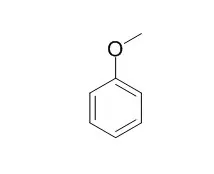| Structure Identification: |
| Applied Catalysis Volume 49, Issue 1, 3 April 1989, Pages 109–123 | | Design of synthetic zeolites as catalysts in organic reactions: Acylation of Anisole by Acyl Chlorides or Carboxylic Acids Over Acid Zeolites[Reference: WebLink] |
METHODS AND RESULTS:
Acylation of Anisole with phenylacetyl and phenylpropanoyl chlorides and phenylacetic and 3-phenylpropionic acids was carried out in a batch reactor at 50–115°C over a series of zeolites Y at 21, 50 and 100% Na+ exchange, with a framework Si-to-Al ratio from 9 to 24 and on HZSM-5 and H-β zeolites. The products observed were the corresponding acids and the para-substituted aryl ketones. Only trace amounts of the ortho isomers could be detected, and phenol and cresols were absent from the reaction mixtures. When phenylpropanoyl chloride and phenylpropionic acid were used as the acylating agent, 1-indanone was also formed. From the relative adsorption constants of phenylacetyl chloride and Anisole on HY-100 zeolite, and the absence of any Anisole demethylation and rearrangement products, it was concluded that the interaction of the acid sites with the Anisole oxygen must not be very strong. On the other hand, the influence of the level of Na+ exchange on the initial rate of formation of 1-(4-methoxyphenyl)-2-phenyl-phenylethanone shows that the activity of the catalyst is independent of its acid strength distribution. This was confirmed by studying the influence of the framework Si-to-Al ratio on the turnover numbers (TON). The relatively small TON differences could be related to the hydrophobicity of the samples. By using zeolites with different pore size and configuration it was observed that while Y and 5β zeolites show similar behaviour, the medium-pore ZSM-5 fails to catalyse the acylation of p-cresol with phenylacetic acid for steric reasons.
CONCLUSIONS:
Finally, it was observed that zeolites give a much higher ratio of inter- to intramolecular acylation than a typical Lewis acid such as AlCl3. | | Rapid Commun Mass Spectrom. 2004;18(7):808-15. | | Anisole, a new dopant for atmospheric pressure photoionization mass spectrometry of low proton affinity, low ionization energy compounds.[Pubmed: 15052564 ] | Atmospheric pressure photoionization (APPI) is a novel method of ionization in liquid chromatography/mass spectrometry (LC/MS).
METHODS AND RESULTS:
It was originally developed in order to broaden the range of LC/MS ionizable compounds towards less polar compounds that cannot be analyzed by electrospray (ESI) and atmospheric pressure chemical ionization (APCI). Studies done thus far have shown that non-polar compounds that earlier were not ionizable in LC/MS can indeed be ionized by the use of APPI. However, the best ionization efficiency for low polarity samples has been achieved with low proton affinity (PA) solvents that are not suitable in reversed-phase LC (RP-LC).
CONCLUSIONS:
Here it is demonstrated that the signals for analytes with low proton affinities in acetonitrile can be increased 100-fold by using Anisole as the dopant for APPI, which takes the sensitivity to the same level achieved in the analysis of high PA analytes. |
|






 Cell. 2018 Jan 11;172(1-2):249-261.e12. doi: 10.1016/j.cell.2017.12.019.IF=36.216(2019)
Cell. 2018 Jan 11;172(1-2):249-261.e12. doi: 10.1016/j.cell.2017.12.019.IF=36.216(2019) Cell Metab. 2020 Mar 3;31(3):534-548.e5. doi: 10.1016/j.cmet.2020.01.002.IF=22.415(2019)
Cell Metab. 2020 Mar 3;31(3):534-548.e5. doi: 10.1016/j.cmet.2020.01.002.IF=22.415(2019) Mol Cell. 2017 Nov 16;68(4):673-685.e6. doi: 10.1016/j.molcel.2017.10.022.IF=14.548(2019)
Mol Cell. 2017 Nov 16;68(4):673-685.e6. doi: 10.1016/j.molcel.2017.10.022.IF=14.548(2019)